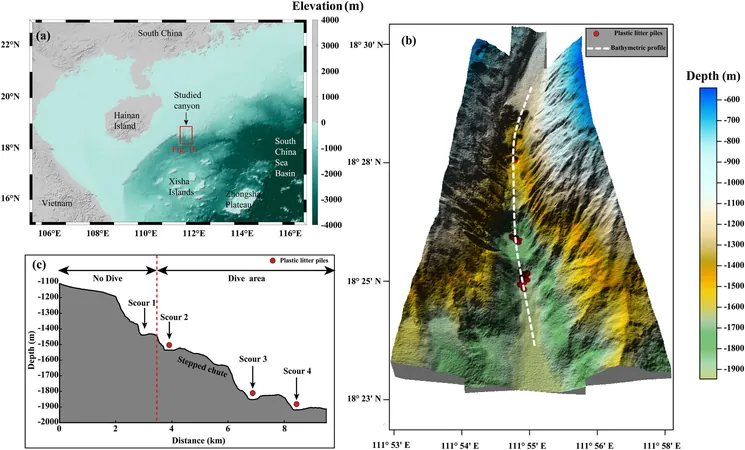
Turbidity Currents Cause Alarming Plastic Accumulation in Submarine Canyons, Study Reveals
2024-11-27
Author: Rajesh
Introduction
Plastic pollution is wreaking havoc on our ocean ecosystems, and new research is shedding light on a crucial aspect of this issue: the role of turbidity currents in transporting and accumulating plastic waste in submarine canyons. Experts estimate that over 10 million metric tons of plastic infiltrate our oceans annually, posing a dire threat to marine life and habitats.
The Depth of the Problem
While many of us focus on the visible plastic debris floating in our seas—with heartbreaking images of sea creatures entangled in nets or suffocating from plastic bags—the reality is that the problem extends much deeper than the ocean's surface. For instance, during the exploration of the Mariana Trench in 2019, scientists discovered a plastic bag nearly 11,000 meters below sea level, illustrating how extensive plastic contamination has become.
Role of Turbidity Currents
The study highlights that although smaller plastic particles may sink and settle on the seafloor, larger pieces are often dynamic, moved by turbidity currents—powerful flows of sediment-laden water that can surpass speeds of 20 meters per second. These enigmatic currents not only reshape the seafloor and deepen existing canyons but also carry substantial loads of sediment and pollutants deep into the ocean.
Research Methodology
Published in the Geophysical Research Letters, this groundbreaking research by Dr. Yupin Yang from Southern University of Science and Technology in China combines bathymetric data and imagery captured from submersible dives in the South China Sea between 2018 and 2020. Using advanced computational fluid dynamics models, the study meticulously simulated how different hydraulic parameters influenced sediment dispersal and plastic accumulation in submarine canyons.
Key Findings
The researchers identified specific features within the canyon morphology as key contributors to the behavior of turbidity currents. Remarkably, they found that concave scours up to 30 meters deep acted as trapping mechanisms for debris, with a staggering 88% of the observed plastic waste found concentrated in just four such geological features in the study area.
Understanding Shear Velocity
Dr. Yang emphasizes that the shear velocity—an indicator of stress at the base of these turbulent flows—significantly governs where debris settles. They observed that a lower shear velocity corresponded with increased deposition of sediment and plastic litter, particularly plastic bags, highlighting the unique behavior of these materials compared to traditional sediments.
Implications of the Research
Critically, the research indicates that plastics do not conform to established deposition patterns dictated by their density. Instead, their buoyancy allows them to move freely, potentially traveling vast distances across the ocean floor. More vigorous turbidity currents can later disturb previously deposited plastics, sweeping them even deeper into the subaqueous environment for extended periods.
Conclusion
As we grapple with the urgency of plastic pollution, understanding the dynamics of sediment and debris transport in these underwater systems is vital. This study not only provides insight into how plastic accumulates in submarine canyons but also underscores the need for comprehensive strategies to combat oceanic plastic pollution. The question remains: How many more hidden plastics lie deep beneath the waves, waiting to be uncovered?


 Brasil (PT)
Brasil (PT)
 Canada (EN)
Canada (EN)
 Chile (ES)
Chile (ES)
 España (ES)
España (ES)
 France (FR)
France (FR)
 Hong Kong (EN)
Hong Kong (EN)
 Italia (IT)
Italia (IT)
 日本 (JA)
日本 (JA)
 Magyarország (HU)
Magyarország (HU)
 Norge (NO)
Norge (NO)
 Polska (PL)
Polska (PL)
 Schweiz (DE)
Schweiz (DE)
 Singapore (EN)
Singapore (EN)
 Sverige (SV)
Sverige (SV)
 Suomi (FI)
Suomi (FI)
 Türkiye (TR)
Türkiye (TR)